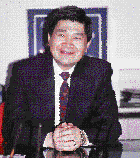ASIAN CALIFORNIA
Page 3 of 12
Chinese Americans: THE NEW ESTABLISHMENT
 he Chinese were the first Asians to immigrate in sizable numbers to California. That head start has helped keep the Chinese as America's largest Asian population--2.2 million. In California, they number 1.3 million, 4% of the state. The initial wave of immigration began in 1850, just a few short years after a miner named James Sutter found a few nuggets of gold at the bottom of a tin pan while prospecting near Sacramento. It was the beginning of the California Gold Rush economy, peopled by the eager miners themselves, the newly assembled boomtown flotsam and jetsam and the xenophobic establishment of newly-created and powerful mining companies. They all combined to keep the Chinese out.
he Chinese were the first Asians to immigrate in sizable numbers to California. That head start has helped keep the Chinese as America's largest Asian population--2.2 million. In California, they number 1.3 million, 4% of the state. The initial wave of immigration began in 1850, just a few short years after a miner named James Sutter found a few nuggets of gold at the bottom of a tin pan while prospecting near Sacramento. It was the beginning of the California Gold Rush economy, peopled by the eager miners themselves, the newly assembled boomtown flotsam and jetsam and the xenophobic establishment of newly-created and powerful mining companies. They all combined to keep the Chinese out.
| "It's a common belief among the Chinese that we should help each other. Wherever you go in the world, you will meet someone who knows someone you know." |
Chinese blood, sweat and lives built the western half of the first transcontinental railroad, allowing the industrial revolution to spread across the nation. Others gravitated to cities like San Francisco and opened specialized retail shops, restaurants and laundries, among other enterprises. Some started small factories involved in the manufacture of apparel and footwear. The Chinese plugged the many holes in the American economic fabric and kept the mill of U.S. business running smoothly. Without their strong work ethic and dedication to better themselves, California's mining, agricultural, dry goods and fishing industries may have floundered.
The Chinese immigrants were sometimes subjected to intense demonstrations of bigotry, usually from the mouths of newly founded white labor unions. The Immigration Act of 1882 was just one more slap in the face. In a move of staggering American shortsightedness, it denied citizenship to existing immigrants and closed the door to future newcomers from China for decades to come. The Chinese were forced to band together, forming the Chinatowns of San Francisco and Los Angeles--ghettos of small, family-run businesses--noisy, cramped enclaves to keep the Chinese community confined and ignored.
"Asian immigrants formed some of the earliest racially-defined and geographically-based communities in urban America," says J.D. Hokoyama, president and executive director of Leadership Education for Asian Pacifics (LEAP). "Long before the establishment of black ghettos in New York's Harlem and Chicago's South Side, the Chinese were forced by racial violence and legal restrictions to retreat into Chinatowns throughout the West, establishing the first ethnic enclaves in the country."
With the U.S. entry into the Second World War, two important changes occurred for the Chinese. The number of servicemen overseas left a glut of jobs to be filled, and having China as a wartime ally changed the American perspective of Chinese Americans from "foreigners" to "good guys." They were now different, "bettter" than the hated and feared Japanese enemy. So, diplomas in hand, large numbers of Chinese for the first time began entering the professional workforce.
In 1943, America repealed the Chinese Exclusion Act, allowing the gates to be cracked open just a bit. In the two decades that followed, 45,000 new Chinese immigrants were granted visas. Add to that relatives and spouses and the real Chinese immigration figure jumps to about 60,000. The competition was tough. The U.S. only allowed in those with skills and education vital to American industry or those with close family.
  Upper: Bill Mow helped usher
in the personal computer age with his pioneering device for measuring
semiconductor speed. After suffering a racially-motivated
slight by the executives of the company that acquired his Macrodata, he
turned his energies to founding Bugle Boy which goes
head to head with Levi-Strauss in the casualwear market.
Upper: Bill Mow helped usher
in the personal computer age with his pioneering device for measuring
semiconductor speed. After suffering a racially-motivated
slight by the executives of the company that acquired his Macrodata, he
turned his energies to founding Bugle Boy which goes
head to head with Levi-Strauss in the casualwear market.
Lower: David Lee stunned IBM and Xerox by inventing the first daisywheel printer, then later developing a superior laser printer. |
Meanwhile in China, the Communists were advancing and those who could, scrambled to get out. Many of these immigrants of the mid '50s and early '60s began to reject Chinatown and settled just outside of Los Angeles in cities like Monterey Park and Alhambra, which are home today to thriving Chinese communities. Page 4
| Page 1 |
2 |
3 |
4 |
5 |
6 |
7 |
8 |
9 |
10 |
11 |
12 |
CONTACT US
|
ADVERTISING INFO
© 1996-2013 Asian Media Group Inc
No part of the contents of this site may be reproduced without prior written permission.
